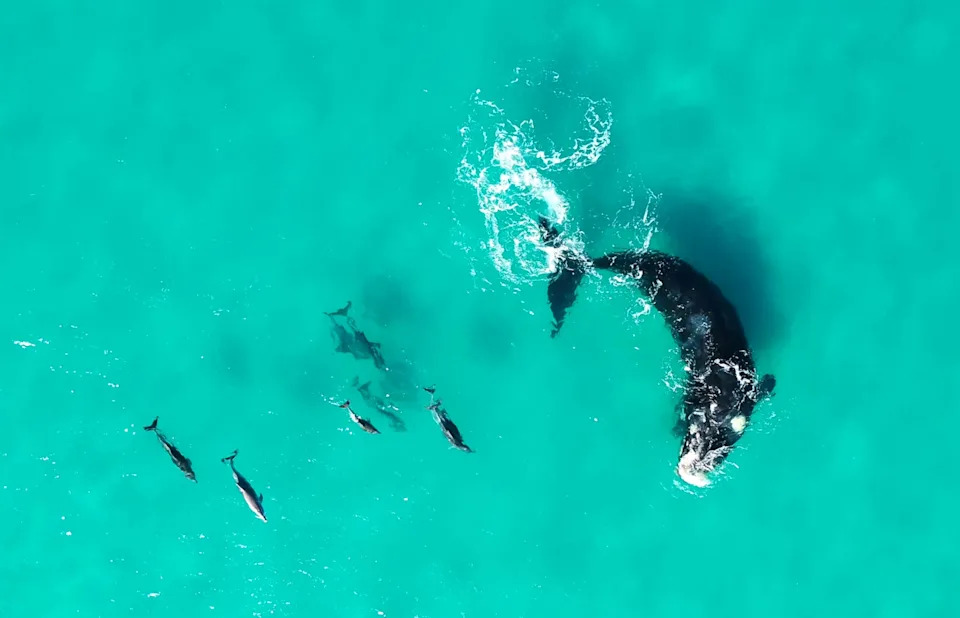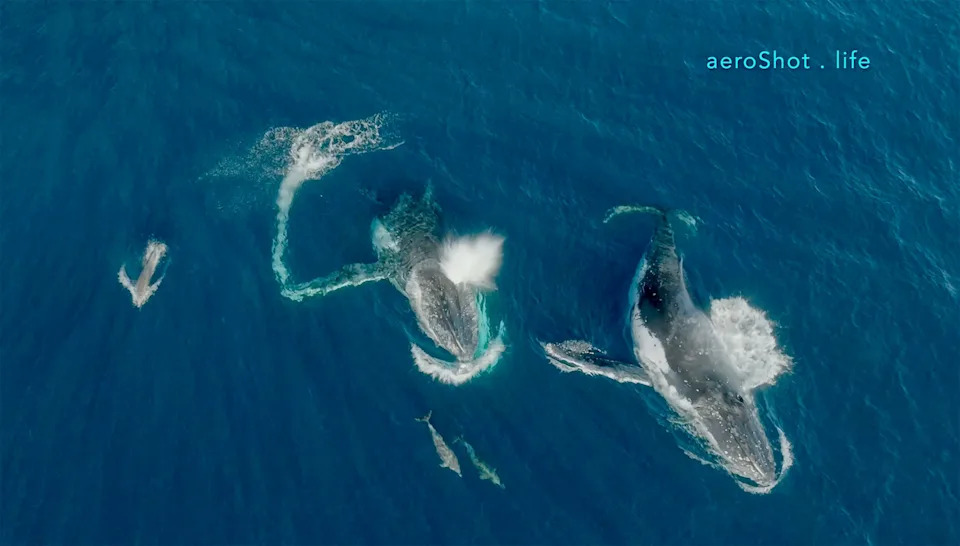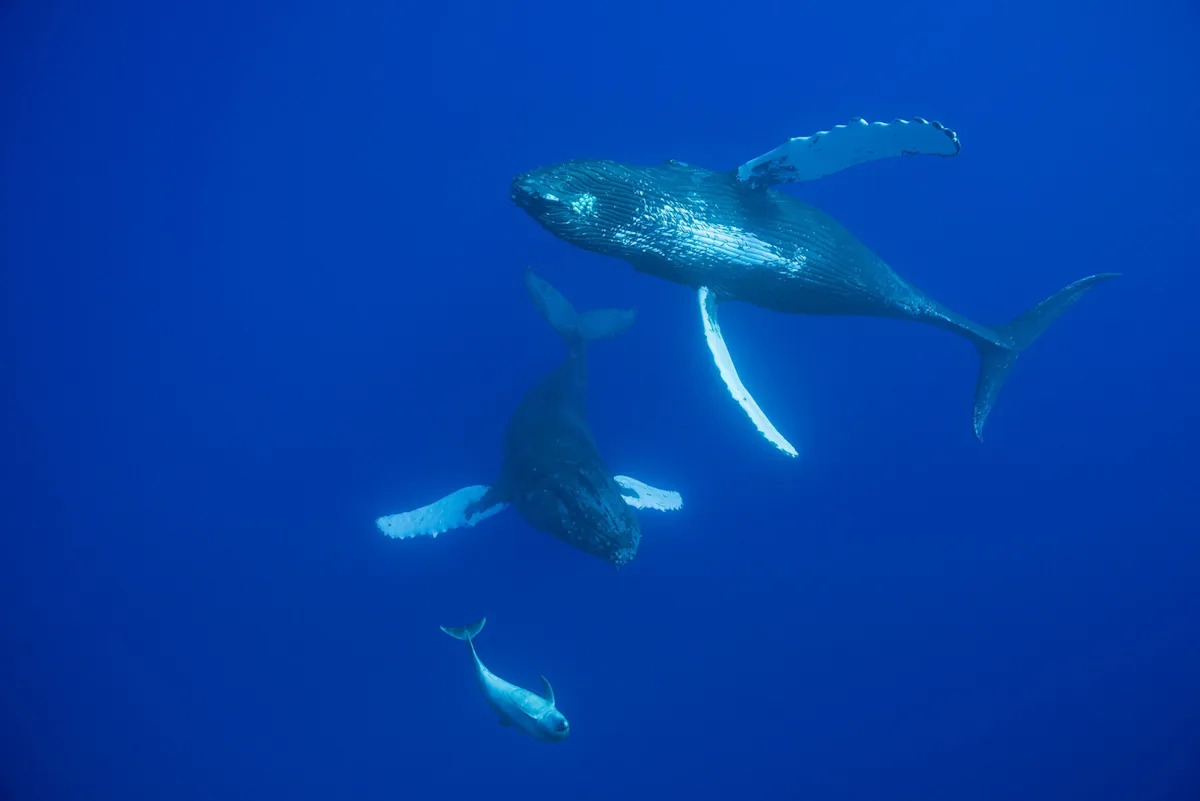As the humpback whales soar along at the surface just off the coast of Australia, tiny splashes ahead indicate that they’re not alone. A pod of bottlenose dolphins darts along at the front of the group.
This scene captured by a “crittercam” attached to one of the whales is just one example of baleen whales and dolphins interacting with each other in the wild—and it might be much more common than scientists realized.
After analyzing videos and photos of 199 instances of whale-dolphin interactions between 19 species around the world, researchers found that a quarter of all the whale-dolphin encounters could be “a possible positive interaction,” according to a study published today in the journal Discover Animals. It’s unclear exactly how aware the animals are of each other or whether these are signs of playfulness—or just vibes.
(Do these dolphins have orca “friends”?)
Possible positive interactions between dolphins and whales
The team scoured social media for imagery of contact between the two cetaceans in oceans around the world, plus two videos captured by the crittercams.
In 80 percent of the encounters, the dolphins swam close to the whales’ heads, suggesting a mutual awareness or even that the dolphins might be trying to attract the whales’ attention, says Olaf Meynecke, a co-author on the study who leads the whales and climate program at Griffith University in Queensland, Australia. In a handful of examples, the dolphins appeared to rub or touch the whale on purpose.
The animals’ close proximity “would indicate that they are seeking either direct contact, or at least visual contact,” he says.
In several instances, the dolphins went bow riding—saving energy by surfing the wave created in front of the swimming whale—near the whale’s head, or rostrum, in the same way they often do with boats. “Were dolphins close to the rostrum because they were enjoying a fast ride, or was it actually to seek contact with the whales?” Meynecke wonders.
Dolphins are often observed frolicking around whales but such behavior has “historically been looked at as the dolphins playing with this big thing in the ocean,” says Thea Taylor, managing director of the Sussex Dolphin Project in England who wasn’t involved in the study, “but there hasn’t been much record of the whales interacting and playing back.”

Researches analyzed nearly 200 videos and photos of of whale-dolphin interactions between 19 species around the world. Photograph By Jaimen Hudson
When Meynecke and his colleagues analyzed the footage closely, they realized that some whales seemed to respond.
Do whales seek out dolphins?
Based on the documented behaviors, some whale species seem to reciprocate the dolphins’ friendly approaches more than others. Humpback whales in particular—believed to have an affinity for other species because they sometimes intervene when orcas attack whales, seals, and even sunfish—were more amenable to the association.
Out of all documented hangouts with humpbacks, “at least one third of the interactions we classified as positive, with the humpback whales actually seeking out swimming towards the dolphins,” says Meynecke.
Humpbacks rolled from side to side and showed their bellies, which is often associated with socializing or courtship, as well as extending their pectoral fins towards the dolphins. Meanwhile, Gray whales rolled, which is seen during courtship as well as when these curious animals try to get a better look at a tourist boat. Southern right whales slapped the water with their pectoral fins—also associated with communication and social interaction.
“It’s really interesting to see that back-and-forth play, rather than it just being one directional,” says Taylor.
(Read more about the hidden world of whale culture.)
In two baffling instances, humpback whales lifted a bottlenose dolphin up on its rostrum. Taylor didn’t know what to make of this but didn’t see it as an aggressive action. “They’re normally more vigorous movements like tail slaps or head slaps.”

Some baleen whale species appear to be more prone to interactions with dolphins than others. Photograph By Wildlive Media
Contact between cetaceans isn’t always positive. In England, researchers have recorded dolphins killing porpoises before abandoning the carcass—scientists don’t know why but, as they’re not eating the meat, it might just be fun. “That’s a slightly darker side of what could be play,” she says.
Some species documented by the study were less impressed by the dolphins than affable humpbacks—fin, blue and northern right whales showed little to no reaction.
(Whales could one day be heard in court—and in their own words.)
The importance of play
As well as being fun, play is important for cognitive and social development. “Dolphins are heavily reliant on their social networks for foraging, hunting, and breeding,” says Taylor. “Just like in humans, play is a fantastic way of reinforcing their social bonds.”
Understanding whether distinct species seek each other out for play helps experts better understand their distribution, which could better inform conservation efforts and bolster public support for protection measures.
It’s a strategy that’s worked in the past. Before 1970, most people had no idea that whales could sing. When a marine biologist released an album of these haunting melodies and people heard whale song for the first time, it transformed how connected they felt to these huge mammals. “Understanding that cetaceans play, just like we do, can inspire a similar emotional bond,” says Taylor.

